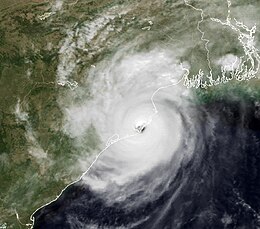1999 Odisha cyclone
| Super cyclonic storm (IMD scale) | |
|---|---|
| Category 5 (Saffir–Simpson scale) | |

The cyclone on 29 October at its record peak intensity as it made landfall on Odisha
|
|
| Formed | October 25, 1999 |
| Dissipated | November 1, 1999 |
| (Remnant low after October 31, 1999) | |
| Highest winds |
3-minute sustained: 260 km/h (160 mph) 1-minute sustained: 260 km/h (160 mph) |
| Lowest pressure | 912 hPa (mbar); 26.93 inHg (Record Low in North Indian Ocean) |
| Fatalities | 9,899 (Using IMD figure. Some estimates range up to 30,000) |
| Damage | $4.44 billion (1999 USD) |
| Areas affected | Myanmar, Bangladesh, India (particularly Odisha) |
| Part of the 1999 North Indian Ocean cyclone season | |
The 1999 Odisha cyclone (IMD designation BOB 03,JTWC designation 05B) was the strongest recorded tropical cyclone in the North Indian Ocean and among the most destructive in the region. The 1999 Odisha cyclone organized into a tropical depression in the Andaman Sea on 25 October, though its origins could be traced back to an area of storms in the Sulu Sea four days prior. The disturbance gradually strengthened as it took a west-northwesterly path, reaching cyclonic storm strength the next day. Taking advantage of highly favorable conditions, the storm rapidly intensified, attaining super cyclonic storm intensity on 28 October before peaking with winds of 260 km/h (160 mph) and a record-low pressure of 912 mbar (hPa; 26.93 inHg). The storm maintained this intensity as it made landfall on Odisha on 29 October. The cyclone steadily weakened due to persistent land interaction and dry air, remaining quasi-stationary for two days before slowly drifting offshore as a much weaker system; the storm dissipated on 1 November over the Bay of Bengal.
Although its primary effects were felt in a localized area of India, the outer fringes of the super cyclone impacted Myanmar and Bangladesh. Ten people were killed in the former, while two were killed in the later by the storm's rainbands. The storm was the most severe to strike Odisha in the 20th century, raking the state and adjacent areas with high storm surge, powerful winds, and torrential rainfall. The storm's impacts exacerbated the damage caused by a very severe cyclone that struck the same region less than two weeks earlier. The 5-6 m (16-20 ft) surge brought water up to 35 km (20 mi) inland, carrying along with it coastal debris and inundating towns and villages. The surge combined with heavy rains to produce widespread flooding, damaging around 1.6 million homes and causing rivers to breach 20,005 flood embankments. The storm's effects destroyed numerous crops, including sugar cane, rice, and other winter-time harvests. Although estimates of the death toll varied significantly—at times suggesting 30,000 fatalities—the Government of India enumerated 9,887 fatalities in the country, of which a majority were caused by storm surge; over 8,000 deaths occurred in Jagatsinghpur. The total damage cost of the destruction wrought by the super cyclone amounted to US$4.44 billion.
...
Wikipedia
